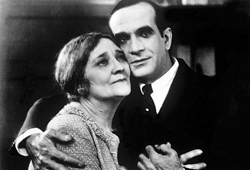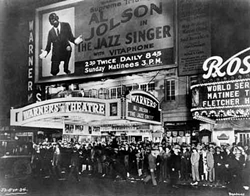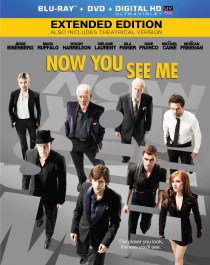
Known as the “Father of the Talkies”, The Jazz Singer was the first film to match sound and picture. By 1927, some short subjects had already been “talkies,” and even a few features had some bits of synchronized music, but The Jazz Singer was the first to put them altogether on the Silver Screen. Though the plot is simple (it was based on a Broadway play), the film drew large crowds to the theaters to see one of the most popular singers of the day, Al Jolson. As a young Jakie Rabinowitz, the son of a synagogue cantor, he is expected to follow in the foot steps of his father (a fourth generation cantor himself), but his heart longs to sing jazz tunes instead of “Kol Nidre.” Forced to leave home, he changes his name to Jack Robin and pursues a life on Broadway. As a skillful singer, you will see that his songs are actually a form of storytelling that are full of life and emotion. Equally fun is Jolson’s talking scenes, complete with some playful banter with his mother. When he looks out over the audience and says, “You ain’t heard nuthin’ yet,” you can hear that enthusiasm in his voice.

The movie goers must have been astonished by the sound of his voice up on the Silver Screen. However, I must admit, other than the historical significance of this film, I found the actual story to be a bit slow moving and long. Most likely this is because I have seen this story played out many times over the years in other films that used this common plot line. I would not recommend this film to the casual film buff that is looking to be entertained for the evening. For the collector, however, this movie is a “must have”.
Warner Brothers had just purchased Vitaphone, a company that produced records a year earlier, and they placed their reputation on the success of this film. My guess is, if this film had flopped, “talkies” would have been delayed by another decade. In any case, the whole soundtrack of The Jazz Singer was synchronized from a record to the film. Most of the movie is silent with only Jolson’s singing and a few ad-lib lines providing a break in the background music soundtrack. In total, maybe 15 minutes of this movie has actual talking and/or singing.

Jolson’s numbers include his blackface act, a longstanding staple of minstrel shows and music halls. Though this seems uncomfortably “politically incorrect” by today’s standards, the use of blackface was not unusual for the time, especially on Vaudeville. This is most likely why you will never see this movie on the T.V. today. Jolson’s use of it, in my opinion, was never in mockery, but was actually a salute to the originators of jazz, an American musical art form from which Rock-n-Roll is an off shoot.

The film is nicely restored on blu-ray and Warner includes 2 DVDs full of extras to compliment this historic film. For the most part the picture is clean and generally sharp. A few scenes look a bit rough and fuzzy, but considering the age of the original print, I can’t fault it too much. A souvenir booklet containing program stills, and ads are quite interesting. A 90-minute documentary gives a detailed account of how the Vitaphone gear worked and how later systems became the industry standard. Just so you know, the soundtrack is DTS-HD Master Audio 1.0 and the sound is clear and virtually hiss free. In some of the long shots of Jolson singing I noticed lip synch issues, but the up close shots were perfectly timed.

Supplements include a cornucopia of extras. A Plantation Act is more Jolson in blackface with a cotton field backdrop, Hollywood Handicap is a studio short comedy directed by the venerable Buster Keaton. I enjoyed the ’36 Tex Avery cartoon I Love to Singa which spoofs the movie with a character called Owl Jolson. I actually remember seeing it on TV when I was a wee lad in the 60’s. The DVDs make up over 4 hours of Vitaphone shorts including : Vaudeville acts by George Burns and Gracie Allen in a short called Lambchops, the Foy Family doing crazy stage acts, jokes by Shaw & Lee, the racy songs of Trixie Friganza, and Bernardo De Pace, the “Wizard of the Mandolin”. All of these acts from a by-gone ear are yours with the price of admission to The Jazz Singer digibook. My final recommendation: this film is for the serious collectors, but certainly worth renting if you want to experience a wonderful by-gone era in movie history.
Here are a few musical clips from The Jazz Singer:


